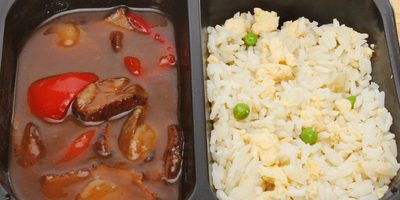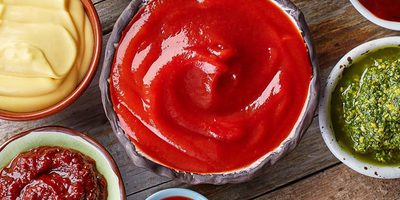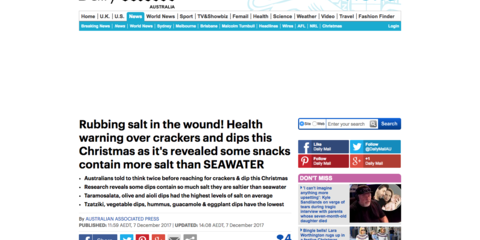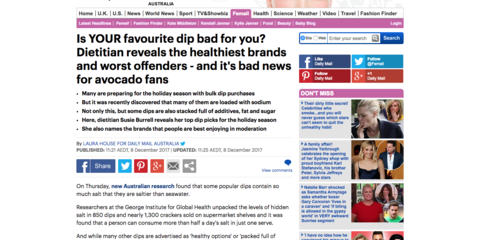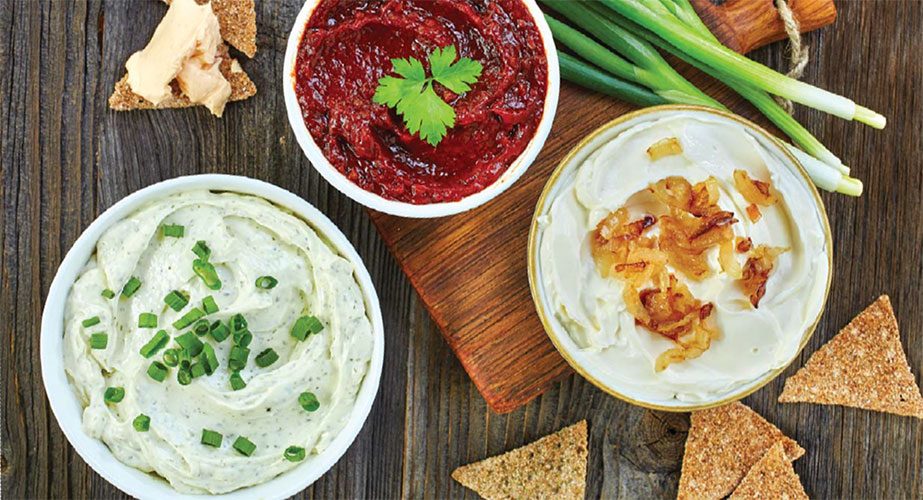
Research reveals that many healthy-looking dips are saltier than seawater
Download the table of results: ten highest salt levels in crackers per 100g (PDF 201KB)
This Christmas, partygoers might think they’re eating healthily when they reach for crackers and dip. But new research released today shows that some dips are saltier than seawater, and several cracker-dip combinations deliver more than half a day’s worth of salt in just one serve.
Released today by the George Institute for Global Health, VicHealth and the Heart Foundation as part of their Unpack the Salt campaign, the report analysed salt levels in 849 dips and 1285 crackers from Australia’s four major food stores from 2010 to 2017.
The report revealed a 16 per cent drop in the average amount of salt in crackers since 2010 – in line with national targets for manufacturers. But it also showed a concerning 14 per cent increase in the average saltiness of dips over the same period.
Heart Foundation Victoria CEO Kellie-Ann Jolly said the fact that crackers now have less salt is good news and shows some manufacturers are making their products healthier.
“But the increase in salt levels in dips is worrying and indicates an urgent need for a national target to help cut Australia’s salt intake and save thousands of lives,” Ms Jolly said.
Key findings:
- One serve of any of the three saltiest dips (2.4 g/serve) with one serve of the saltiest cracker (0.5g/serve) contained almost 3g of salt – over half the recommended daily maximum
- There was a massive difference in the amount of salt in dips. The saltiest dip, Fresh Fodder Taramosalata, contained 4.8g salt per 100g - 1.5 times saltier than sea water, and almost 400 times saltier than the least salty dip.
- The lowest salt dip, Pipel Avocado dip contained no salt, followed by The Olive Branch’s tuna pate (0.05g /serve), and Fresh Fodder’s Babaganoush and Yalla Tzatziki (both 0.13g/serve)
- Olive based dips, on average, were the saltiest of all the dips, containing on average 2.1g of salt per 100g
- The average amount of salt in dips has increased by 14% since 2010 while the average amount in crackers has decreased by 15.9%.
- The lowest average salt content was found in tzatziki, spinach and guacamole dips, with 0.9g of salt per 100g
- The saltiness of crackers varied from zero salt to 5.3g per 100g, with a range of unflavoured rice cakes from SunRice, Ceres Organics, Pure Harvest and Damora containing no salt. But seven different flavoured rice cakes and crackers were on the “top ten saltiest” list
- Rosemary & Sea Salt Kurrajong Kitchen Lavosh Thins Original were the saltiest crackers, with 0.5g salt per 10 g serve. The four saltiest crackers tested all contained more salt than sea water.
Ms Jolly said that the average Australian was still consuming close to nine grams of salt a day – almost twice the World Health Organization recommendation of five grams a day.
“Excess salt is directly linked to high blood pressure, which increases the risk of stroke, heart and kidney disease,” she said. “One of the best ways to keep your blood pressure down is by eating less salt.”
The George Institute’s Public Health Nutritionist and the report’s lead author Clare Farrand said crackers and dips may seem like a healthy choice. But after unpacking the facts, it’s clear that salt levels vary greatly between products, and some contain shockingly high amounts of salt.
“Olive, seafood and aioli dips had the highest average salt content of all the dips. Meanwhile tzatziki and vegetable dips, such as hummus, guacamole, eggplant and spinach dips, had the lowest average salt contents,” Ms Farrand said.
“Christmas partygoers don’t get to see the labels and should remember that they will often end up eating three to five times more than the modest 10g to 20g serving size quoted on labels.”
“So if you’re at a party, try to fill up on fresh food such as cut-up fruit and vegetables before you reach for the dips and crackers. And if you’re a diehard dip fan, tzatziki, spinach or guacamole dips are usually the safest bet.”
VicHealth CEO Jerril Rechter urged festive party hosts to visit the Unpack the Salt website before they shop to feed their friends and family. The site was launched by VicHealth and the Heart Foundation to raise awareness about the high levels of salt in processed and packaged foods.
“Dips and crackers are a Christmas party favourite and you don’t have to give them up altogether. You can try making your own – the Unpack the Salt website has great recipes – or choose lower-salt options at the supermarkets,” said Ms Rechter.
Ms Rechter said food manufacturers had a huge role to play in helping keep the nation healthy and this data showed that reformulation to reduce salt levels can be done.
“While the average drop in salt in crackers is pleasing, there are still brands with very high salt levels. We need more commitment from food manufacturers to reduce the amount of salt in their products.”
Tips for consumers
- You don’t have to give up dips altogether. Try making your own (go to unpackthesalt.com.au for recipe ideas). Or go for tzatziki or vegetable dips and think about using carrot or other vegetable sticks instead of crackers
- The best way to reduce salt is to eat more fresh foods and reduce your reliance on processed and packaged foods
- Sodium is one component of salt – it is the sodium that is labelled on nutrition information panels on packaged foods
- Note the serving sizes that manufacturers use when quoting different foods’ salt content – they’re often smaller than you think. And be aware of your own portion sizes – they’re often larger than you realize
- To reduce salt in your diet and for your family, it’s important to know how to check the amount of sodium listed on packaged foods. Use the ‘per 100g’ column to compare the sodium content of different brands
- Download the FoodSwitch app (find it at foodswitch.com.au). It allows you to scan the barcode on packaged food products to find out their sodium content and to find an alternative product with a lower sodium content
- Look for dips with less than 400mg of sodium per 100g. The Heart Foundation has a sodium and salt converter that easily allows you to convert the sodium listed on packaged foods into grams of salt, or vice versa.
- Visit unpackthesalt.com.au for more information about the campaign and for tips and resources on how to identify salt in packaged foods and reduce your salt intake



